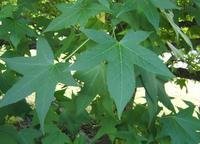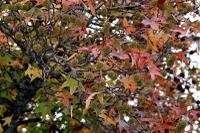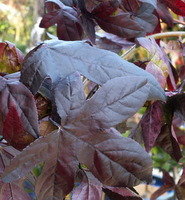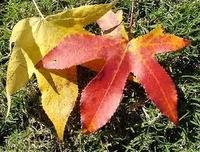





My neighbor has a sweet gum tree in her back yard. My house sits on a diagonal downhill slope from hers, and I have the most glorious view of the tree in the fall. Of course, that means I get her sweet gum balls that roll downhill into my yard, too. And yes, it is truly worth it.
(Editor's Note: This article was originally published on September 29, 2009. Your comments are welcome, but please be aware that authors of previously published articles may not be able to promptly respond to new questions or comments.)
Sometimes when I walk up the slope of my back yard to visit my neighbor, I slip and stumble over all the sweet gum balls that fall from her tree and on to the ground. I have never minded that, because I think those thorny balls are the price we pay for enjoying the beauty of the tree in the fall. I have thought about having one for my own yard, but with three maples, one oak, two raintrees, two hollies, two magnolias, two Japanese maples, one redbud, and a weird one that is named bald cypress, I don't think another tree would stand a fighting chance.
I am not sure that I love the tree as much as I love the memories associated with it.
The sweet gum, Liquidambar styraciflua, was highly prized in the mountains where I grew up. I learned a lot of its history from my great Aunt Bett. A descendant of the Cherokees, she used it in the same ways of her ancestors, as medicines, as tonics, and as an antiseptic. I learned early to treasure and respect certain plants, because she told me that everything had a reason for being, including trees. The sweet gum was no exception.
It grows in moist woodlands, on rich well drained soils, in bottomlands and near swamps. Aunt Bett's grew in her back yard, right on the bank of the creek that ran beside her garden and her house. That was a cold mountain fed stream, and rarely did it ever change its temperature, except on cold days when its surface froze, leaving the water below still streaming. The tree is native to North America, and it grows from Connecticut west to southeast Missouri and eastern Texas, then southward into Mexico and Central America.
It can grow to be at least 140 feet tall, but more commonly the ones I have known are about 80 feet. It has a gray bark, with corky ridges on its twigs. The leaves are starshaped, with five to seven finely toothed, pointed lobes. Tiny yellowish green flowers can be seen in April and May, clustered in separate spherical male and female flowerheads.
Some of its history I wrote down long ago, I know that when the Spanish explorer Cortez dined with the Aztec emperor Montezuma, cigarettes of tobacco flavored with sweet gum were brought to them after the meal. The amber colored gum, or balsam, gives the sweet gum tree its flavor and its common name. Native Americans reportedly made a preparation of the balsam to treat fevers and wounds. In the South some pioneers chewed sweet gum leaves to cure diarrhea. In the Appalachians, people dipped the twigs in whiskey and nibbled them to clean their teeth. That must have been a practice gone long before I came along, because I never saw it done. Aunt Bett made sure I knew about it though. I do remember that she made an ointment by mixing the balsam with tallow or lard, but I only remember that it was used to lessen swelling around cuts and injuries and for some other skin infections. I can't tell you if it worked, I only know that she believed it did.
It was the balsam that was important, I think. Dried balsam, called storax, is now listed in the U.S. Pharmacopeia. Guatemala and Honduras are the main sources of storax which is also used to flavor soft drinks, tobacco, candy and chewing gum. Somewhere in all my readings, I saw that it is also used to scent some perfumes. I think it would surely have to be those that have a woodsy or spicy scent.
When I think about it, I believe the sweet gum was one of those plants that Aunt Bett trusted and didn't feel that it required caution. Only a few did she treat in that way. I never had to wear an asphidity bag around the sweet gum tree. Herbalists use the balsam as a curative medicine, the food industry uses it as flavoring, and the gardeners plant the tree for its brilliant fall foliage. I think in this instance, Aunt Bett knew exactly what she was talking about.
So my neighbor and I chat beneath her sweet gum tree, and it always happens to shed one of its balls directly onto my head. I really don't mind, because it brings back such fond memories. One year I talked my parents into getting some newly invented spray paint and I sprayed those sweet gumballs red and hung them on the Christmas tree. Another time I cut a wreath shape out of the side of a brown corrugated box that a recently purchased appliance had come in. I glued sweet gum balls all over it and sprayed it all white to hang on our green front door. I have added them to rose petal potpourri, just as a textural effect, and I have piled them in among arrangements of other dried weeds and flowers. Their spines are quite sharp, and I don't remember using them as weapons as I did with pawpaws and persimmons. Thank goodness .
.
The tree is a lovely addition to a yard, if you have room for it. The sweetgum balls are aggravating, but I think the beauty of the tree's fall colors outweigh the backache you get from picking them up out of your yard. You might even give your neighbor one for Christmas, and you could enjoy its fall colors without the backache.
Information is from my own writings, and contemporary findings came from several sources, the primary being Wikipedia. Photos are all found in Plant Files. Thanks to these fine photographers: Frostweed for the thumbnail of colorful leaves, sarahskeeper for the green foliage, Melody for the fall foliage, Jeff_Beck for the gold and red leaves, and bootandall for the dark purplish leaves. Your photos always make our articles beautiful.
Copyright © www.100flowers.win Botanic Garden All Rights Reserved